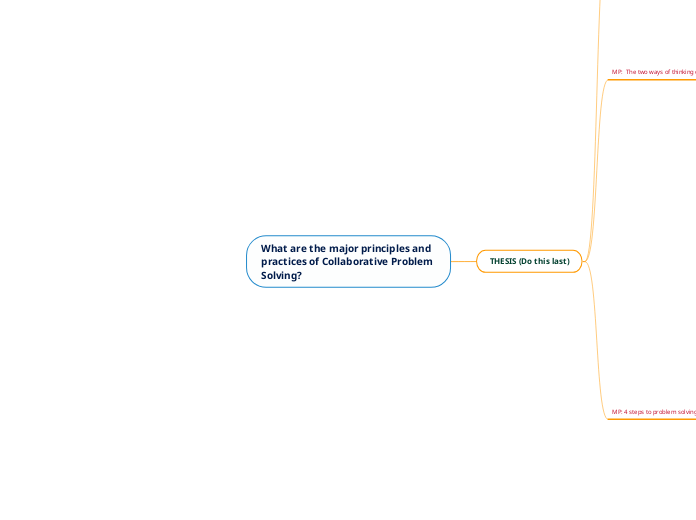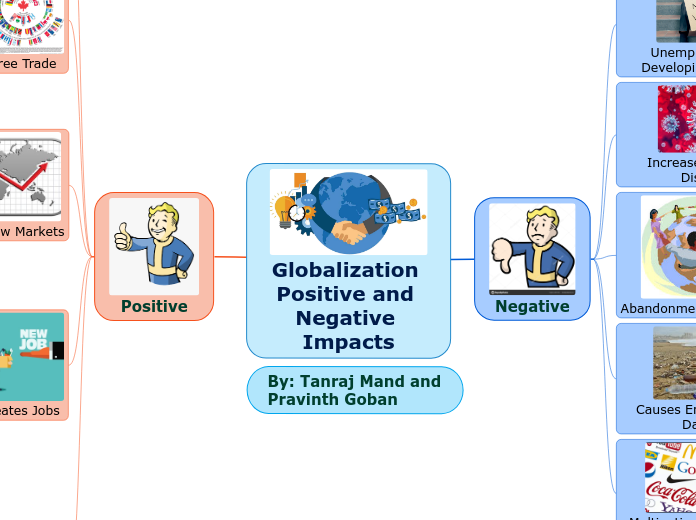What are the major principles and practices of Collaborative Problem Solving?
THESIS (Do this last)
MP: 4 steps to problem solving.
MP: create a shared agreed upon solution with the other people or person involved in the conflict.
Having common ground with the other involvents is found by trying out new solutions and discover they have more common ground then anticipated.
Common ground refers to both parties searching for a shared solution that already exists but has not been fully uncovered.
New solutions are all around you once needs are open and part of the collaborative discussion. Using common ground is a great way to further the process of finding the best solution for everyone.
One a solution has been selected, make sure anyone involved in the conflict has accepted the solution. Often, other needs can be discovered when finding a solution, bringing you back to the evaluation stage.
MP: Brainstorm new ideas to meet the needs of all parties.
Brainstorming refers to deep thinking and creative ideas in order to create a shared solution meeting all needs
Brainstorming requires both parties to have expressed all needs that have been hidden by positions.
Once all needs are known, everyone must work together collaboratively to create a solution, meting all needs.
MP: identify the needs of everyone involved.
MP: Using self assertion through the use of " I statements".
Using statements which include "You" putting blame on the other person makes them feel attacked and will progress the conflict only further in the wrong direction.
I statements are statements where one expresses their position through their needs feelings and stories.
Using I statements are used to express oneself perspective of a conflict in a relaxed manner.
MP: Using empathic listening in Collaborative problem solving.
show empathy for other person, express understanding of distress and upset that has been dealt with.
Empathic listening refers to the practice of showing understanding for the problem one is expressing in a conflict.
listen and show understanding of others position through creative, intuitive summarization back to other person.
showing understanding through summarization, is an easy way to show the other person that you are listening and care about their position and humanity.
simply repeat back to the other person their problem in your own words. Also be sure to feel and show empathy toward the other person while summarizing.
Empathy shown to the other must be genuine. To show empathy is to discover the compassion for the other persons needs through love.
Let the other person speak and express themselves when they feel they need to.
letting the other speak when they feel they need too, furthers the expression of all information needed to fully understand the problem.
have an open, and collaborative mindset to corrections of your understanding.
interrupting the other or speaking too much, can silently, silent the others needs.
it is important to let the other person speak when they choose in order to give them a chance to express their needs.
MP: Separating all needs from positions is crucial in order to create a true solution meeting needs.
Needs, are most often the very source of motivation we have to hold on to a position. Revealing needs from positions in a conflict is the first step to uncovering the true feelings and motives of anyone involved.
to separate the needs from positions, one must identify the position motivated by the uncovered needs, then, remove the position as a whole from the conversation once the uncovered needs are on the table.
problem solving is far easier once needs and positions have been separated. As well, positions at this point, should naturally become less discussed without the motivation of hidden needs being expressed.
Ask genuine creative questions about the others position
asking questions shows the other person you want to further your understanding of their needs and position.
this will create new opportunities for both parties to move away from conflict and start to create a shared solution.
MP: connect to the humanity of the other
connecting humanity helps show other person there is empathy towards them, reducing stress and anger in the conversation.
humanity means we are all human and all have different perspectives and ways of processing information. Understanding this
show understanding and compassion towards other persons position and needs, even if the needs do not make total sense.
doing this helps turn any conflict to a more collaborative mindset in all parties
MP: The two ways of thinking of conflict
viewing conflict as collaborative problem solving.
Understanding the perspective of the other person makes them feel as they are truly cared for, and as though their needs are finally being tended too, creating a more tranquil environment to express needs.
Understanding the perspective of the other person is not done any one way, but it takes time, any questions necessary to understand, and compassion for the others position.
Strive for compassion from the other person.
Once the other has found a reason to show compassion toward the other side. The conversation changes to a much more collaborative problem solving conversation.
having compassion gives one the ability to feel for the other, and help create new solutions out of love.
To gain the compassion of the other, one must show compassion the other person to create a environment to be mimicked the other way.
This is practiced by showing high levels of compassion, giving credulity to the others position, along with self insertion through I statements. These all require courage
Courage, in this sense, refers to the confidence and outgoingness of one attempting to gain compassion for the other creating a cycle of needs and feeling rather then a zero sum game.
MP:collaborative problem solving is based on the distinction between needs and positions, and asserting ones own needs in order to come up with a meeting point towards said needs.
It is important to have self interest. Make sure your needs are communicated just as much as the other person.
Understanding the needs of the other, lets the other person know that they are understood and feel a more significant level of credulity and safety from humiliation.
Make sure to show the other a high level of credulity towards their story, needs, and feeling. Show them they are heard and they have a reason to feel how they do.
Humiliation is what we all fear, positions are crafted as a defense mechanism which include hidden needs, and the position created to avoid humiliation.
removing humiliation from a conversation often changes positions or uncovers needs.
MP: viewing conflict as a competition.
Competition refers to having rivalry for supremacy.
Two or more people want different things and they want to win the argument, because one with the viewpoint of someone who wants to compete wants nothing more then a win and a loss on the other side.
Conflict as a competition refers to a back and forth type of discussion fueled by anger and the avoiding of shame. in order to come to a conclusion where one wins what they want at the expense of the other.
both people just want to "win" the argument and are not really trying to solve anything.
no real needs are met or even acknowledged. One only "wins" at the expense of the other, this is also referred to as a zero sum game.
what is conflict?
MP: conflict, is any form of disagreement or argument between two or more people.
conflict occurs when 2 or more people have needs that are not met, and or, are being hidden by positions in an argument.









